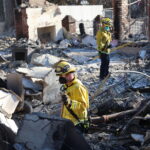As victims of Superstorm Sandy pick up the pieces of their lives and insurers wade through thousands of claims, industry and public officials are raising concerns about fraud.
Since the storm, the National Insurance Crime Bureau (NICB) has issued two warnings to consumers and insurers about disaster-related fraud.
According to Todd Fannin, director of claims for LexisNexis, an industry workflow products provider, adjusters handling Sandy claims need to be on the lookout for fraud.
“With catastrophes such as this and as widespread as it is, it pretty well impacted across all insurance lines. Some of the main ones…are going to be on the homeowner insurance side, the auto, business interruption and life insurance as well,” Fannin said.
Fannin said disaster fraud is more likely to be an opportunistic crime unless fraud rings were already pre-existing, such as auto body repair shop or healthcare collusion activities.
Disaster fraud is equally as likely to be committed against an insured by a contractor as it is by an insured against an insurer, he said.
Contractor fraud can include price gouging, such as in the latest warning from the NICB about unscrupulous towing companies. A contractor might also commit theft by taking deposits and not completing the work.
According to the LexisNexis claims director, a contractor might inflate pricing or the insured themselves might inflate their own claim by stating that something was stolen and/or lost in the storm that was not or by causing additional damage in order to increase the value of a claim.
It’s difficult to estimate the costs related to disaster-related fraud.
“Overall, across the industry, on an annual basis, all lines up, the cost of insurance fraud is $80 billion plus. When you look at that, it’s usually about 10 to 12 percent of all claims coming in. That percentage is probably about the same for the catastrophic events such as this, usually coming in more so after the initial rush of claims,” Fannin stated.
He outlined the types of fraud, which is more likely to occur on the back end of a disaster, affecting homeowners’, auto and business interruption lines.
Homeowners’ Fraud
Very often fraudsters take advantage of uncertainty surrounding home insurance coverages. “One of the biggest issues that we see, especially with the hurricanes, is the misunderstanding that most of the public has as to what is really covered, and especially the fact that in most situations, a storm-surge or flooding-type situation is not covered by insurance,” said Fannin.
Homeowners confronted with the realization that the majority of their loss may not be covered could become upset, he said.
“After Hurricane Katrina, there were several buildings that mysteriously caught on fire after they were inspected and determinations were made as to the amount of coverage that was actually going to be made available,” Fannin stated.
He said there were homes that appraisers and estimators looked at where it was clear that the damage to the roofs had occurred post-storm.
“Obviously, if the rain comes in through the roof, rather than being a flood situation, there’s potential of the claim being covered,” he said.
Adjusters should be on the lookout for content claims fraud, too.
“Potential issues, where somebody may either have removed items from their home, in anticipation of the storm coming, to protect them, and then making a claim that they were damaged and/or stolen after the storm by looters. The inability to produce photographic or actual financial receipts to show the purchase of some of these higher-end items are some things that the adjusters should be looking for,” Fannin said.
Auto Fraud
According to the NICB, there were 325,000 cars flooded as a result of Hurricane Katrina.
“Unscrupulous salvage operators and dealers often try to conceal from potential buyers the fact that vehicles have been damaged by a natural disaster,” said NICB President and CEO Joe Wehrle.
In the wake of Sandy, Fannin recommended adjusters confirm the cars they inspect were actually damaged in the storm itself.
“Having lived in Florida and dealt with some hurricanes down there, it was amazing the number of people that decided to drive their cars to an area that was said to be under the potential for flooding and, gosh darn, it actually did and the car washed away,” he said.
According to Fannin, even though cars may be flooded, they can still be functional.
“Many of these cars will be cleaned, potentially some of the interior replaced with very inexpensive items, and then put on the market and sold as used vehicles. The problem with that…is with the salt or brackish water that can cause corrosion of the electronic connections. So, many of these cars, down the road, will start having some problems and the consumer out there buying them could be caught unaware,” Fannin stated.
In 2009, the Justice Department started requiring salvage yards, body shops and other entities that deal with total loss vehicles to report them to the National Motor Vehicle Title Information System, called NMVTIS.
“So when a car’s totaled nowadays, that has to be reported. And it’s about an 88 percent compliance,” Fannin said.
Adjusters need to make sure the vehicle is operational, inspect the interior and check for prior claims and prior branded titles.
“They should look for some kind of mud type of linage, to show how high the water actually got inside the vehicle, because if water did not get inside the vehicle, then it’s probably not a total loss unless it came in through the trunk area somewhere,” Fannin stated.
Business Interruption Fraud
Fraud related to business interruption claims may be the most difficult to discern.
“Lots of claims can be made as to what was going to occur, how much it costs to run things, how many individuals they were not able to bring back,” Fannin said. “Business interruption is a really tough one, but it could be widespread up there with the power outages and the time that it’s going to take for everybody to get back online.”
Adjusters should review the steps a business owner took to try to bring the business back online, the restoration company’s mitigation process and the bookkeeping records.
Customer Service Impacts Disaster Fraud
In his experience, having worked several hurricanes, Fannin has found that adjuster attitude, as well as the way in which a claim is handled, can impact whether an insured will inflate a claim.
“If they feel that they’re being treated fairly, they feel like the adjuster cares and that they are truly going out of their way to help them in a very bad situation, I found that most of the insureds greatly appreciated it and dealt more fairly back with the insurance company. If they feel that they are being taken advantage of, there’s a natural tendency at that point to then take a similar tack with the insurance company,” Fannin said. “I think adjusters need to, while they’re looking for fraud, think about how their actions could potentially affect where that claim goes.”
Listen to the podcast interview with Todd Fannin: Disaster Fraud in the Wake of Hurricane Sandy
Was this article valuable?
Here are more articles you may enjoy.

 Catastrophe Experts Tap AI to Tackle Soaring Insured Losses
Catastrophe Experts Tap AI to Tackle Soaring Insured Losses  Alibaba Teams up With BMW to Develop AI for Cars in China
Alibaba Teams up With BMW to Develop AI for Cars in China  Auto Insurer Fined for Data Breach That Impacted 45K New Yorkers
Auto Insurer Fined for Data Breach That Impacted 45K New Yorkers  After the Flames: Preparing for the Growing Fraud Threat in Los Angeles
After the Flames: Preparing for the Growing Fraud Threat in Los Angeles 